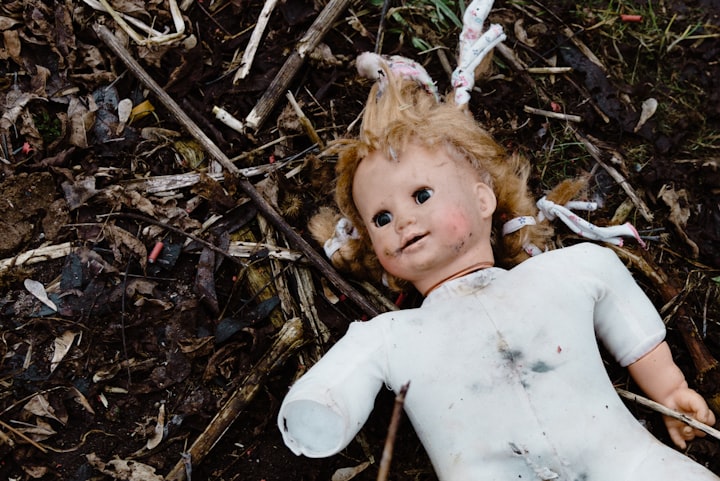The "Weird World"
The real-life story of one woman's journey into a dangerous & secret world

Even as a young girl, Pauline was always aware something about her childhood was very off.
Her father, Warren, was a successful businessman. He was a heavy drinker, who could become violent and after a while, Pauline’s mother, Ruth, couldn’t take it any more. They separated when Pauline was five, as she was due to start school.
Pauline, her mother and her little brother Ted moved house a lot. Pauline recalls when she was nine, her mother packed up their Volkswagen camper van. She told them they were going on holiday to Winnipeg, which was over 1,000 miles away. Only once they got there, over a mug of cocoa, Ruth broke the news to them that they were never going home.
“1974 was the last time I thought of my family as having any relation to normal,” writes Pauline in Run Hide Repeat, her memoir, which is available on Amazon. “The events that followed made Ted and I know we were different, somehow apart. Ted would sometimes, in the years that followed, refer to ‘normal families’. Not in a critical way, but in a straightforward acknowledgement that we were not one. My brother and I would say, ‘What do you think is wrong with our family? Why are we so weird?’ But that was the mystery that just didn’t get answered.”

Over seven years, Pauline attended six different schools.
By now she had lost touch with her father, Warren. “There was no opportunity to say goodbye, it was just this abrupt, severing of relationships,” Pauline says. When she asked her mother, there was never a good explanation. “She would only say, ‘I’m sorry, I can’t tell you, when you’re older I will tell you.’”
When Pauline was 13 they moved to New Brunswick, on Canada’s eastern coast. Pauline was finally settled in a school, had made close friends, and was becoming interested in boys. This time, Ruth actually told them where they were going — to New Brunswick, in Canada. Pauline and Ted were sworn to secrecy, but Pauline told her best friend, Wendy. When Ruth came to pick her up from Wendy’s house, they had to act natural so Pauline’s mother wouldn’t suspect anything
Ruth promised her children that one day she would tell them what was going on. Why they couldn’t tell anyone where or when they were going on holiday. Why they couldn’t even say if they were going out for dinner. Pauline heard the brush-off, “I’ll explain when you’re older,” time and time again. They’d start again and build a new life in a new town. But Pauline was confused, anxious and falling into depression. “I knew something bad was happening,” she says. “I didn’t know what it was, but there was always a sense of something dire that was unspoken.”
Another man had come into the family’s life around the same time Ruth & Warren were separating. A church minister called Stan Sears. Pauline’s mother had met Stan at a support group for the families of alcoholics. Stan was a counsellor there and Ruth had gone to him when she was struggling with Warren’s drinking. She told Stan that she was preparing to leave Warren.

Pauline had noticed that every time that they had moved, Stan’s family had moved in with them.
“So whatever had been going on they were part of, I knew that,” Pauline says.
Once in New Brunswick, they seemed to settle. By 1988, at the age of 23, Pauline had graduated from university. She started working at a local newspaper when out of the blue, her mother telephoned and asked to meet her. “She said, ‘OK, I’m ready to explain all of these strange things that have happened throughout your life.’”
But the explanation would be far more complicated, and more terrifying than Pauline could ever have dreamed.
Pauline was to meet her mother outside a motel halfway between the two cities they were living in. When she arrived, Ruth said nothing but gave Pauline a note.
The note read: “Don’t say anything. Take your jewellery off. Put it in the envelope. I’ll explain, just don’t talk.”
“It was just the most bizarre thing, I thought, ‘Who are you? What are you doing?’ But I did what she told me.”
When Pauline walked into the motel room, Reverend Stan Sears, was waiting for her.
Stan and Ruth explained to Pauline that for the past 16 years they had been on the run. Allegedly Warren had been involved in organised crime and that Pauline’s family had been targeted by the mafia because of her father. They explained the reason Pauline needed to remove her jewellery, was so it could be tested for bugs and trackers.
“It was unbelievable,” Pauline says. “But I remember a feeling of terror coming over me that this might be something we could never escape.”
Stan said it had all started when he counselled a mafia kingpin who wanted to leave his criminal past. The mob discovered that the man had broken the code of silence, and assassinated him. Then they had then come after Stan because he knew too much.
So, when Ruth — who was the embittered wife of a mobster — had started at Stan’s church, she too had apparently become a target.
“I was then told that each of us had somebody following us, keeping an eye on us from a distance and that there had been many attempts to either kidnap, poison or kill me but that these agents had intervened to keep me safe many times over the years.”
Stan explained he had a direct connection and a beeper, to a shadowy government agency. They had undercover officers who collected intelligence and protected people.
Pauline was in shock, it was too much to take in. “I was sick with fear and sadness and it just felt like life was shattering all around me.”
Pauline spent that weekend listening to Stan and Ruth’s stories. They explained many of the odd things that had happened while she was growing up. Pauline recalled the time she had come home to find her mother throwing away all their food away.
“The story at the time was that the food had gone bad, but I remember thinking, ‘Ketchup and mustard don’t go bad, there are things in there that don’t go bad quickly. Why would you do that?’”
Stan told Pauline that they had heard somebody was trying to poison them, and so everything was disposed of.
There was the time they had gone hiking in the middle of the school week. They had stayed in a mountain cabin. Stand justified this was because people had been coming after them. They had to get away for a few days.
Then there was the time they had skipped school to go bowling. And another time they had come home from school and been told to scrub their feet in the bath. Then they were made to wear plastic bags over their socks for the rest of the day. Stan clarified that was because their carpets had been dosed with poison.

“As unbelievable as it sounds there were all these explanations that made pieces that had been so troubling fall into some kind of a pattern, a narrative”
As a young journalist, Pauline was trained to question everything. However, Sears offered compelling, intricate, details for everything.
“The O” as he called them were organised crime soldiers. “The “Weird World” was a witness-protection community type village.
As much as Pauline was sceptical, these stories seemed to have a twisted logic, in the context of her life. “As awful as the scenario might be, this explanation could mean that at least my family wasn’t just odd or crazy”.
It was a surprise, but not a total shock, when Ruth & Stan told Pauline that they were in love. They explained that for many years, they hadn’t acted on their attraction. Sears was married, but now they had decided to be together.
Stan told Pauline that well as the government-sanctioned taskforce that was protecting them, there were communities in different parts of the country — where people could go into protective custody. Stan called these communities the “weird world”.
Stan said he was already living in one of these communities, called Place of Hope. He said, but his wife hadn’t wanted to go with him, so he was now living alone and working in this “weird world” with the agents.
After years on the run, Pauline’s mother said that she was going to “go inside” for protection. She was going to disappear again. They told Pauline that this was their chance to finally be together. They had been in love for many years, but they had never been able to act on their feelings — now they could.
When Pauline came to leave Stan asked if he could put a transmitter on her car. He said it was to make it easier for the “good guys” to follow her and keep her safe.
He also gave Pauline a small transistor radio, so that Pauline could send a call for help. “He warned me: ‘Only use it if your life is really in danger because people will respond and put their life on the line for you.’”
It was a lot for Pauline to take in.
So, Pauline left with a transmitter in her car and a small transistor radio, rigged so she could call for help.
This was how life went on for five years.
Pauline spent a lot of time looking over her shoulder, and Sears keep her in the loop with updates. Pauline even broke up with her boyfriend because she was scared to tell him about the secret “Weird World”.
More and more alarming information kept coming from Stan.
He told her that many people she thought she knew weren’t who she thought they were.
“The story was that some people who had been around us during my childhood, who were involved with organised crime, had been picked up — arrested, killed or otherwise disappeared — and then replaced by doubles. Sometimes the double was put in place by the ‘good guys’ and sometimes the double would be put in place by the ‘bad guys’, so you were never 100% sure whose double it was. It was espionage.”

Stan elaborated that the doubles spent months studying home videos to learn how to behave convincingly, and used specialist plastic surgeons and make-up artists to perfect their disguises.
People using doubles did have notoriety: Stalin and Hitler, Manuel Noriega and Fidel Castro and the leaders of Panama and Cuba all used them.
Both sides — “the good guys” and the Mafia — used doubles, Sears told Pauline. And plastic surgery and prosthetics ensured the disguises were absolutely perfect.
Pauline was told she would encounter these doubles from time to time.
When Ted got married in 1990, Sears told Pauline & Ruth that some of the guests were doubles. Namely her father Warren & her Aunty, Ruth’s sister, Penny.
Warren had a nevus — a little overgrowth of cells just over the iris of his eye. Pauline was transfixed by this — how had they managed to replicate it so accurately?
“But when I said that to Stan he said, ‘Oh, it’s contact lenses and there’s prosthetics, and there’s this and there’s that.’ There was always an answer,”
Still, when Warren asked Pauline to catch up at his hotel room she declined, fearing she would be killed or kidnapped.
Ruth meanwhile, had become obsessed with the toes of her sister Penny’s double. “Even if she had plastic surgery, how could they copy her bone structure?” Ruth fretted.
“My mother was so upset at that wedding because her sister was supposed to be a double,” Pauline recalls. “She kept saying, ‘But look at her toes, those are exactly Penny’s toes, how could you make somebody else’s toes look like that?’”
Pauline and Ruth received dozens of letters from people. Pauline’s father Warren and her godfather, for example. They were supposedly being held in a top-secret prison, Stan told them.

The handwriting looked authentic. The letters all referred to things from their past. And they were very convincing. “Who on Earth would have time to forge them if they weren’t real?” Pauline could not get her head around it.
The two people telling her these incredible stories were the only people she knew, who were trying to protect her. So she pushed her doubts back out of her mind.
“It was a crazy story and I did have some challenges believing it,” she says. “But if I couldn’t trust them, who could I trust?”
Pauline began to feel her work was irrelevant when her life was in constant danger. And being sworn to secrecy had driven a wedge between her and her boyfriend, and everyone else in her life.
“I just thought, ‘I can’t live like this,’” Pauline decided that she would go inside with Ruth and Stan.
Stan reassured Pauline there would be work for her, that there was a community she could be part of. He told her he was building a cottage for himself and her mother. He also said he could arrange for one to be built for her. He even brought Pauline carpet samples and showed her the house plans and gave her a photo of the horse that was waiting for her.
So Pauline broke up with her boyfriend, left her job, and sold her house. She then moved to Nova Scotia. There she found work and a new home while she and her mother waited for word that it was safe to make their move to their new home.
Stan told them that threats had been made against their family, so if they just disappeared then they would be putting everyone at risk.
Pauline and Ruth were kept updated through Stan that the Mafia knew they were planning something — so they were told to wait until they were given news it was safe.
meanwhile, Pauline met Kevin and Stan allowed Kevin to be bought in on the dreadful secret.
Kevin agreed that he would go inside too with them.
So when they got married — neither Pauline’s father Warren (nor his double) were invited to the ceremony. Stan gave Pauline away. The couple waited to move with Ruth and Stan to their new home in the Place of Hope.
Pauline was still planning and looking at carpet samples for their new cabin, where they would live.
But the time to make their move never seemed to be right.
By 1993, now aged 28 — five years after she had been let into the awful secret — Pauline’s doubts reached fever pitch.
“I was at war with myself and I wanted to find some definitive way to prove it right or wrong,” she says. She was exhausted by the ever-present threat to her life. Pauline started sensing that Stan’s stories weren’t quite stacking up and she started picking holes in them.
She decided to set up a sting.
Pauline set the trap at a time she knew Stan was with Ruth.

Pauline rang her mother and told her someone had broken into her home and told her to ask Stan what she should do.
Stan had always made it clear to Pauline and Ruth that they must never go to the police. They could never report anything as the police couldn’t be trusted. They were told if there was ever any trouble they should come to him. Stand said he had a special contraption in his wallet for receiving messages.
“It would do a Morse code dash and dots message and he would then take out a little notepad and decipher it,” Pauline says.
Ruth called Pauline back a few minutes later. Ruth said she couldn’t talk on the phone, Pauline must go to her house immediately.
“I was terrified because it was the moment that I was going to get the answer to this horrible quandary that I’d been living with,”
Once there Pauline listened, horrified, as Ruth and Stan told her that two people from “the O” had been picked up not far from her house. He told her that they had photographs of her. Apparently they had been following her and had ransacked her home, looking for a present from her father
“That was the moment I knew all of those severed relationships, all of the crazy running, all of the strangeness, it was all a lie. All the moves and disappearances; all the running; all the sick, terrifying stories; all the upheaval; all the isolation. It was all because of a lie. A fucking lie. All made up. All the layered creation of the brilliant, twisted imagination of this man whom I’d chosen to love and trust as a father. I was shattered.”
Pauline was so shell-shocked and angry. It took a week before she could confront Ruth.
And when she did, Ruth was upset — but not because she believed Pauline.
What worried her was that Pauline was putting herself in danger with the mob by not trusting Stan.
Pauline also confronted Stan who told her there had been a mistake. The report about the men must have been incorrect. He assured her there would be a full investigation.
Pauline said her memory of that night was that Stan was upset. Not because Pauline was accusing him of lying — but that she was no longer one of them.
Pauline spent months trying to convince Ruth that Stan had been lying to them. Ruth, however, tried to convince Pauline that she was wrong.
“I was furious and resentful and I thought I hated Stan for a long time. But I finally decided that my mother was not in on this. Stan was making it up, but I just couldn’t think why he would have done it.”

In her search for answers, Pauline went to see a psychiatrist.
“I said, ‘What do you think this could be? He’s clearly not schizophrenic. He does not appear to be psychotic. He’s a professional and well respected. People always talk about what a great guy he is, what could be going on?’”
Whilst still trying to understand why Stan had concocted such an elaborate hoax, Pauline came across an article, about a condition called delusional disorder.
Delusional disorder, previously known as “paranoid disorder”, is a type of serious mental illness. It is a “psychosis” in which a person cannot tell what is real from what is imagined.
The main feature of this disorder is the presence of delusions, which are unshakable beliefs in something which is untrue.
People with delusional disorder experience delusions of situations that could occur in real life. Occurrences such as being followed, poisoned, deceived, conspired against, or loved from a distance are all common.
These delusions usually involve the misinterpretation of perceptions or experiences. In reality, however, the situations are either not true or highly exaggerated.
People with delusional disorder often can continue to socialize and function quite normally. They generally do not behave in an obviously odd or bizarre manner that would raise suspicion. This is unlike people with other psychotic disorders, who also might have delusions as a symptom of another mental disorder.
In some cases, people with delusional disorder might become so preoccupied with their delusions that their lives are disrupted — just like with Stan.
Pauline had already considered and rejected all the more commons forms of mental illness such as psychosis, schizophrenia, paranoia and folie à deux (where delusional beliefs are passed from one dominating person to another more submissive one).
Once she read about Delusional Disorder, Pauline believes, it describes Stan, who was a well-respected, pillar- of-the-community type.
“He was a very compelling guy,” she says. “He was just so intelligent, but also funny and he really connected with people. When he talked to you he really listened. You felt very heard. In many ways, Stan was quite brilliant. He had an amazing mind and that allowed his delusion to become that much more complex. There was an entire cast of characters. It was like a Rolodex and he always knew who they were and the stories that were related to them. It was quite remarkable — I could not do that.”
Pauline contacted the author of the Medical Journal article, a psychiatrist at Harvard University. He was very excited when he heard her story.
He agreed, Stan had all the signs and symptoms of a person with delusional disorder, as did another academic, the leading expert on the disorder.
Finally Pauline was able to put a label on what Stan was suffering from. And it bought her some solace at long last.
Finding a reason for what Stan did may have helped Pauline come to terms with her past, but it can never repair the damage.
“I feel very sad for my mother. She had such a difficult life and she was vulnerable to Stan, mostly because he was a gentle, caring guy — too bad he had this terrible delusion. But I also feel sad for myself and my brother — two little kids whose lives were hijacked.”
Pauline did eventually re-establish a relationship with Warren, her father, but she never told him about Stan or his delusional life that she had been part of for years. “I was afraid to tell him for his own health. And I just couldn’t see what was to be gained.”
Pauline’s relationship with her mother never entirely recovered either. “When I had children things changed,” Pauline says, “because they became a focus for all our love.”
“I hadn’t fully forgiven her at that point, but we both knew that we were out of time to sort through this,” Pauline says. “We had to find some place of peace, and eventually we did.”
Ruth never stopped believing Stan’s story, even after his death in 2005.
The letters from the weird world stopped. There were no more messages from agents. At this point, there could be no doubt it had all been a figment of Stan’s imagination. However, Ruth could never truly let go of the world that Stan created.
Ruth developed ovarian cancer, so she spent the last nine months of her life living with Pauline. She passed in 2010.
“Shortly before she died she tried to warn me to be careful,” Pauline recalls. “I said to her, ‘I don’t need to be any more careful than anybody else. And she said, ‘Oh, Polly, if you don’t believe this how you must’ve hated me.’ And I said, ‘No, I didn’t hate you. I’ve been really angry at you, but I do love you.’”
Sadly there has been considerable collateral damage from Stan’s fantastical world.
Pauline and Kevin divorced, and Pauline accepts that their experiences with the Weird World made their life together very difficult.
Since she found out about Stan’s alternate universe, Pauline has had therapy but states she believes the greatest impact on her recovery has been working on her book.
When Pauline wrote Run Hide Repeat, she feared her readers would think that they were fools. The nominations for her book imply otherwise:
ABOUT RUN, HIDE, REPEAT WINNER OF THE 2018 EDNA STAEBLER AWARD FOR CREATIVE NON-FICTION
LONGLISTED FOR BRITISH COLUMBIA’S NATIONAL AWARD FOR CANADIAN NON-FICTION 2018
SHORTLISTED FOR THE 2018 EVELYN RICHARDSON NON-FICTION AWARD SHORTLISTED FOR THE 2018 ATLANTIC BOOK AWARDS — MARGARET AND JOHN SAVAGE FIRST BOOK AWARD
SHORTLISTED FOR THE 2018 FRANK HEGYI AWARD FOR EMERGING AUTHORS
www.paulinedakin.com






Comments
There are no comments for this story
Be the first to respond and start the conversation.